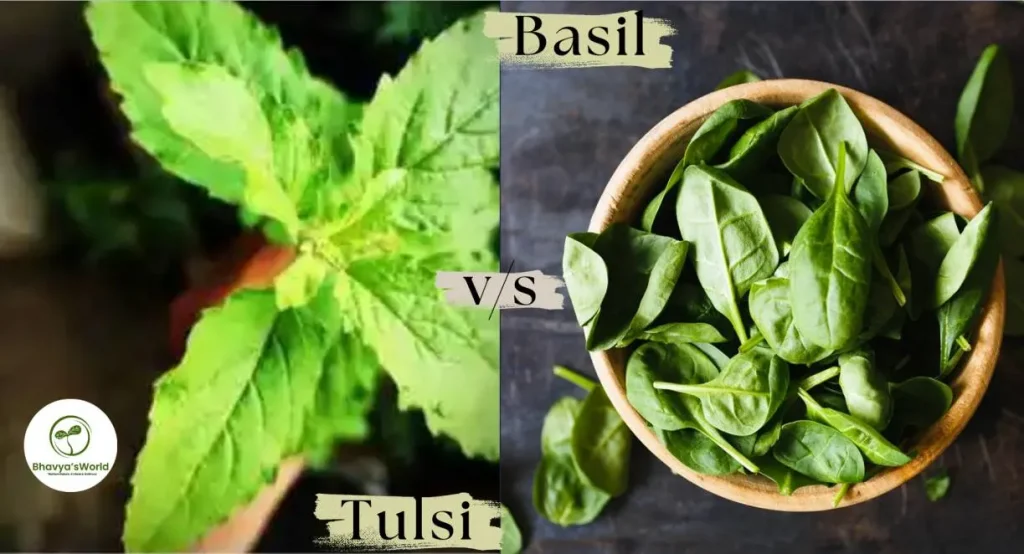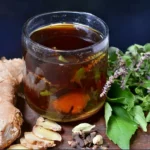Is Tulsi and Holy basil the Same?
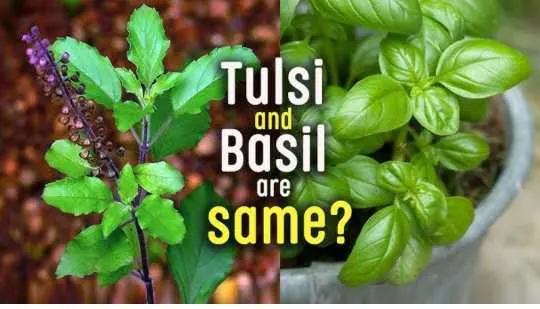
The answer is yes; indeed, Tulsi and Holy Basil refer to the same herb. Specifically, people use Tulsi in the Indian Subcontinent, whereas they use Holy Basil in the West. Moreover, people also know Tulsi as the ‘Queen of Herbs’ for its medicinal, spiritual, and healing properties. Furthermore, it is deeply rooted and plays a very important role in Indian traditions.
The Similarity Between Tulsi and Basil

| Same Plant Family |
| Holy basil, known as Tulsi, and Basil both have the same starting scientific name, which is Ocimum. Moreover, both herbs belong to the same family, i.e., Lamiaceae, which comprises mint plants and culinary herbs like rosemary, oregano, lavender catnip, etc. |
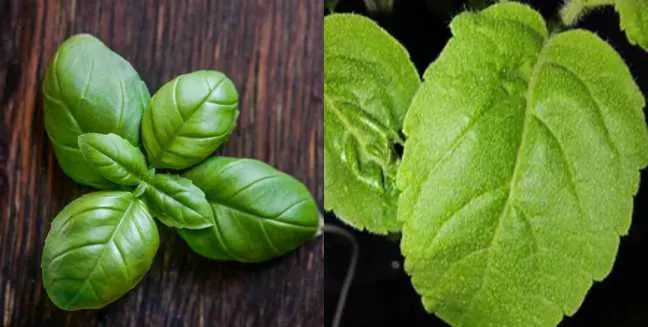
| Appearance |
| Tulsi and basil both have green leaves and small flowers.Both plant leaves are oval shaped. |

| Aromas |
| They both are aromatic perennial plants, which means that they both have a life span of 2 years or more. Additionally, Tulsi and basil both have minty, peppery aromas. |
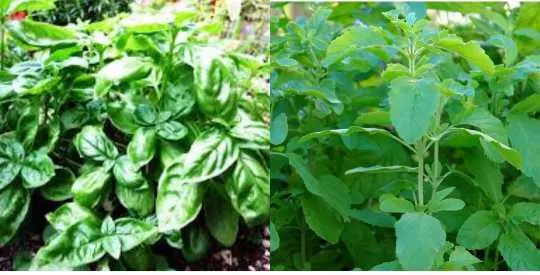
| Medicinal Uses and Properties |
| They both contain antimicrobial, anti-inflammatory and antioxidant properties |
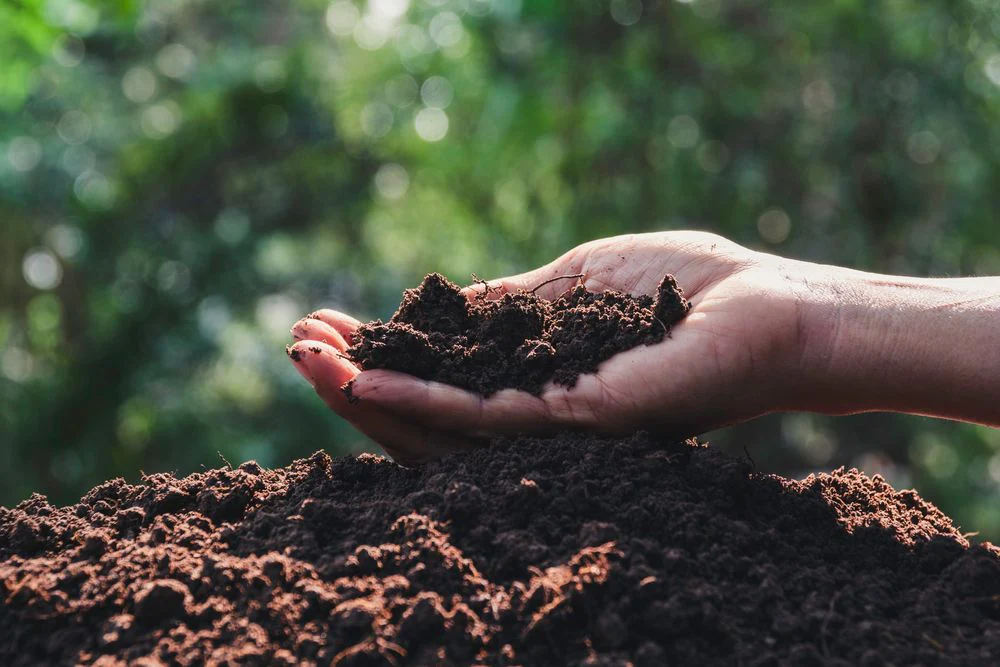
| Planting Requirements |
| Planting of tulsi and basil requires the same climatic condition which is warm climate,they both require well-draining soil. |
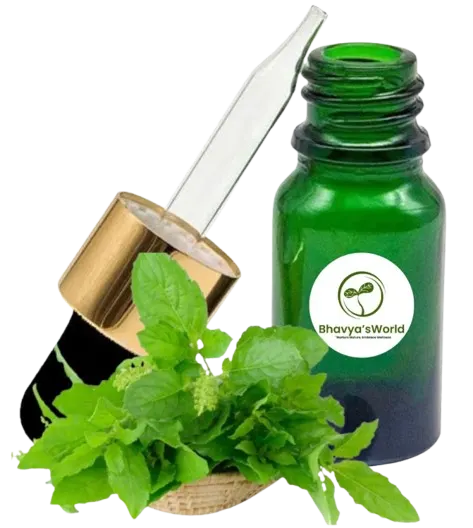
| Essential Oils |
| They contain an aromatic compound, which produces essential oils; furthermore, if they once planted, they will return every year and grow in the same size. Additionally, they both produced essential oils used in skincare and aromatherapy. |
Tulsi vs. Basil: The Key Difference
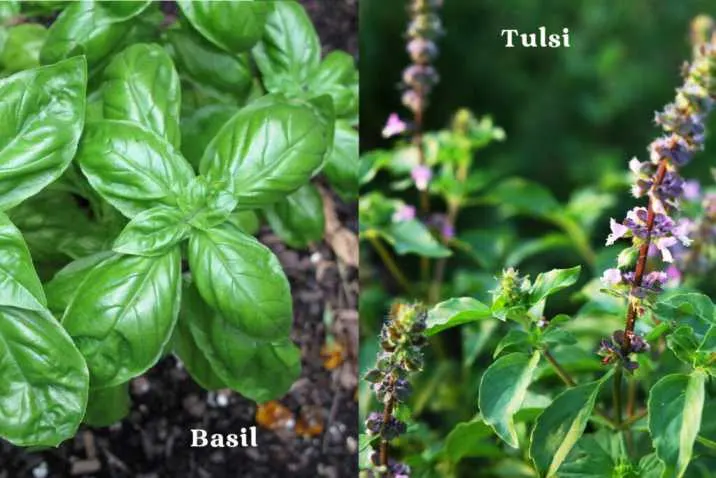
About
Tulsi
Many people refer to it as Holy Basil or Queen of Herbs, gardeners celebrate Tulsi as an aromatic plant celebrated for its numerous health benefits.
v/s
Basil
Chefs frequently call it sweet basil, and cooks utilise this herb in a wide variety of culinary dishes globally. Farmers cultivate it across Africa, Europe, America, and Asia.
Nutritional components
The nutritional difference between tulsi and Basil are:

Tulsi
People know Holy Basil for its amazing medicinal uses. Moreover, it contains an abundance of antioxidants, essential oils, and other natural compounds that contribute to a healthy lifestyle. Additionally, this herb has low calories while being rich in Vitamin A and C, along with minerals such as Calcium and iron.
v/s

Basil
It essential vitamins like Vitamin K, folate, and magnesium. It is rich in fiber, antioxidants, and exhibits anti-inflammatory properties.
Scientific Name
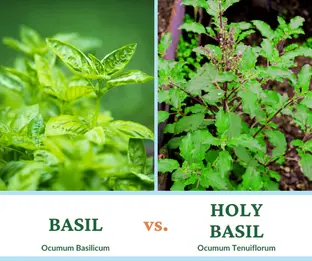
Tulsi and Basil are members of the same botanical family, Lamiaceae. However, if we talk about tulsi vs. basil, it is evident that their initial names are identical, while their last names are different.
Tulsi
Ocimum tenuiflorum ( known as Ocimum Sanctum)
v/s
Basil
Ocimum Basilicum
Tastes and Aroma

Tulsi and basil both have different types with different flavors. If we talk about types of tulsi we get know there are different types of tulsi, such as
Tulsi
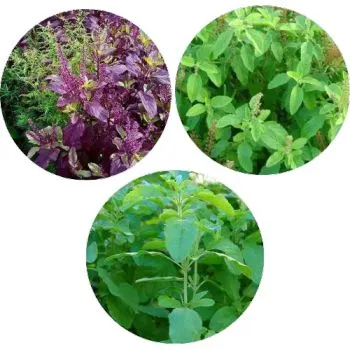
- Rama tulsi: This tulsi has a mild, sweet smell and minty taste.
- Krishna tulsi : It has a hot,peppery,crispy taste and less bitter in taste.
- Vana tulsi : Vana tulsi has a strong and lemony smell or you can say aroma.
v/s
Basil
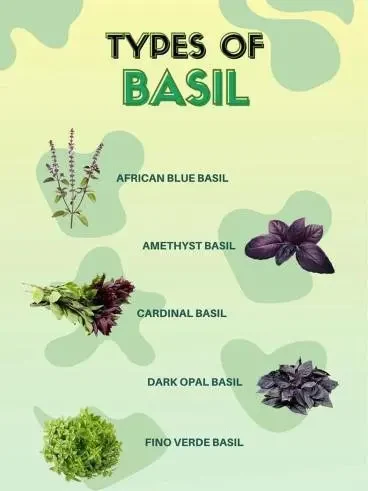
If we talk about types of basil we get know there are different types of basil such as:
- Ocimum Thyrsiflora (Thai Basil): Tastes more like mint basil and can be a little bitter in taste.
- Ocimum Americanum (American Basil): Leaves smell very strong and the taste of curry is very strong and has a pinch of minty flavour.
Appearance
The Lamiaceae family includes over 6000+ species, and consequently, many people cultivate them because of their aromatic leaves and beautiful flowers. Furthermore, you can distinguish between tulsi and basil by observing a few identifiable and distinct features.
Tulsi

- Color and appearance : Hairy stems with green and purple leaves.
- Shape : It has a leaf blade shaped like an egg which is 5 cm long.
- Flower : Small and purplish
v/s
Basil
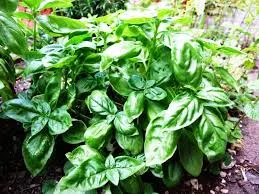
- Shape: Board, oval shaped leaves, and have smooth toothed edges.
- Color and appearance : Bright and glossy leaves.
Origins
If we talk about Tulsi vs Basil origins, they both have a history from their respective origin countries.
Tulsi
Firstly, farmers cultivate Indian basil plants for religious and traditional medicinal purposes. In fact, it grows natively throughout the Indian subcontinent.
Moreover, the Tulsi herb originates from tropical and subtropical areas of Asia, including Southeast Asia. The southern part of South Asia covers India, Sri Lanka, and the Maldives, and parts of East Asia, which icludes Southern China and Taiwan.
v/s
Basil
Farmers cultivate it across Africa, Europe, America, and Asia. Chefs primarily utilize it in culinary application and it is indigenous to Europe and Asia, playing a vital role in Mediterranean and Western cuisines.
Uses & Application
Tulsi

Herbal Tea
Tulsi tea is herbal infusion without any caffeine,full of nutrients and antioxidants.
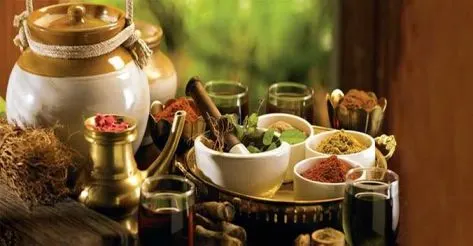
Herbalist says that the holy plant possesses therapeutic properties and is also used in systems of medicine.
v/s
Basil

- This herb is primarily used as a flavouring and in sauces like Pesto,marinara sauces and salads.
- It is often included in fresh or cooked recipes for some flavour enrichment.
- Forms base of pesto and different flavour to salads,pasta,pizza and many more.
- Basil is added to the final step of the recipe as fresh so the herb flavor will enhance the flavour.
- Its leaves are heat sensitive and cooking them makes them lose their flavor.
Other Uses
Tulsi
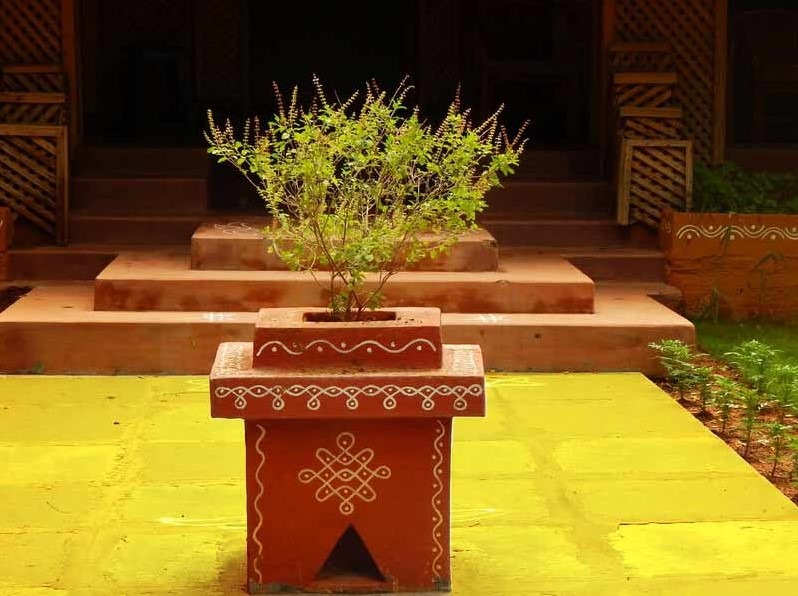
Worshipped in Hindu Culture
Many priests, therefore, recommend that people offer leaves of tulsi in ritualistic worship of Lord Vishnu and his avatars like Krishna and Vitoba. Additionally, people use its leaves in rituals like Puja, and they often believe that putting tulsi in water (Tulsi Jal ) is purifies one’s mind and body.
v/s
Basil
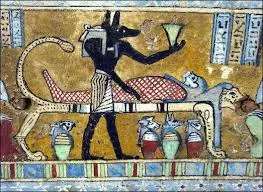
Back in ancient times in Egypt, people used basil in the mummification of mummies and discovered it in their tombs. Ancient Romans considered it sacred and magical, whereas the Greek culture viewed it negatively.
Tulsi vs Basil: Nutritional Components
| Nutrients | Tulsi (Holy basil) | Basil (Sweet Basil) |
| Antioxidants | High | Moderate |
| Vitamin K | Present | Present |
| Vitamin A and C | Low | High |
| Calcium and iron | High | Low |
| Folate and Magnesium | Low | High |
Difference Between Tulsi and Basil in Medicinal Uses

Common Health Benefits
If we talk about Tulsi vs Basil, we will get to know they both have amazing medicinal uses. In fact, it is said that both herbs are very powerful and beneficial for healing.
Additionally, they both include a substance called “cineole” (a natural organic compound that is found in many plants and is also colorless), which possesses a combination of antibacterial, antiseptic, and antifungal properties.
Tulsi Medicinal Benefits
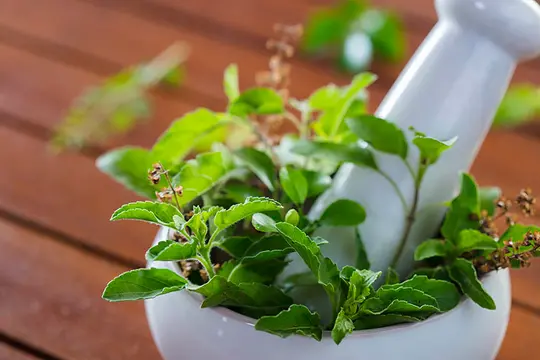
Here I am talking about Tulsi medicinal uses. Specifically, in Tulsi, Eugenol is present which possesses anti-inflammatory, antibacterial, and antimicrobial characteristics.
Furthermore, the Tulsi plant offers benefits such as aiding in the regulation and management of blood sugar levels, while also decreasing insulin resistance.
v/s
Basil Medicinal Benefits

It has minerals like calcium,iron,manganese ,Vitamin K and Vitamin A. Additionally it has essential oils and antioxidants that boost immunity and encourage a healthy lifestyle.
Tulsi vs Basil: Benefits
Tulsi
Religious Benefits

- Protects from misfortune : Its presence in the home is meant to bring prosperity and protect the family from misfortune .
- Warding off negative energy : one of the benefits of Tulsi It is believed that plants can ward off negative energies and let positive energy and vibration enter into homes.
- Watering : It is believed that if we offer water to a tulsi plant on a daily basis it will attract positivity ,prosperity,peace and blessing from gods.
Environmental Benefits
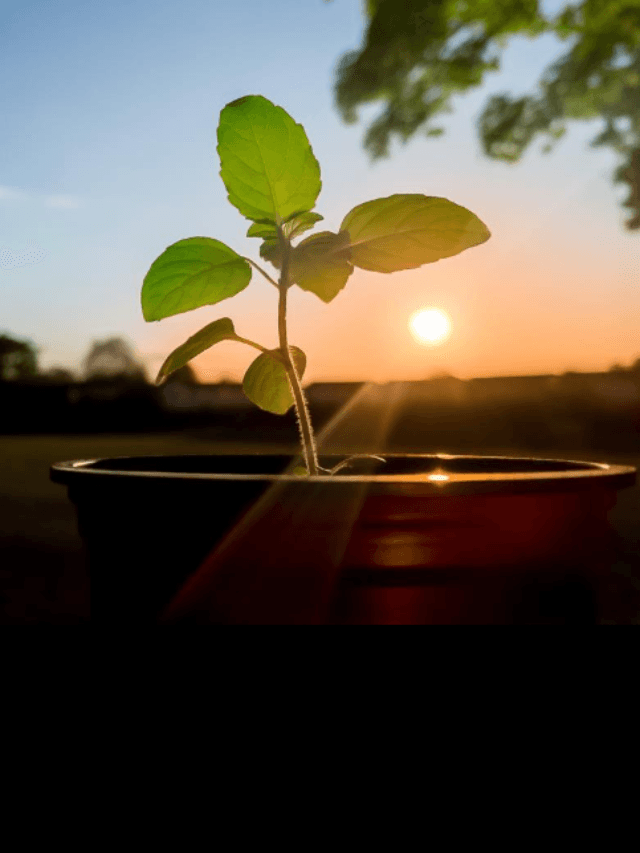
- Environment Purification: It has the ability to purify the air by a good amount of oxygen; furthermore, it tends to absorb harmful carbon dioxide, which, in turn, automatically leads to the improvement of a household’s air quality.
- Connection to nature: Family members reconnect with nature by watering, worshipping, and, furthermore, creating a habit of taking care of Tusli plants. In addition, they engage in various activities related to tulsi plant care as a part of their daily routine.
- Architectural Role: Usually in Traditional Indian homes, people treat the courtyard or Aangan, as a heart of the house; moreover, planting the tulsi there leads to spiritual practices in daily life.
v/s
Basil
As we all know, drying basil makes it highly rich in Vitamin K.
Benefits of Vitamin K

- Clotting of Blood: It helps to produce proteins that cause blood to clot, which is done by the liver.
- Healing of Wound : Basil helps in healing wounds.
- Nausea : It helps to relieve nausea during pregnancy.
Tulsi vs basil : Difference in Vitamin and Minerals properties
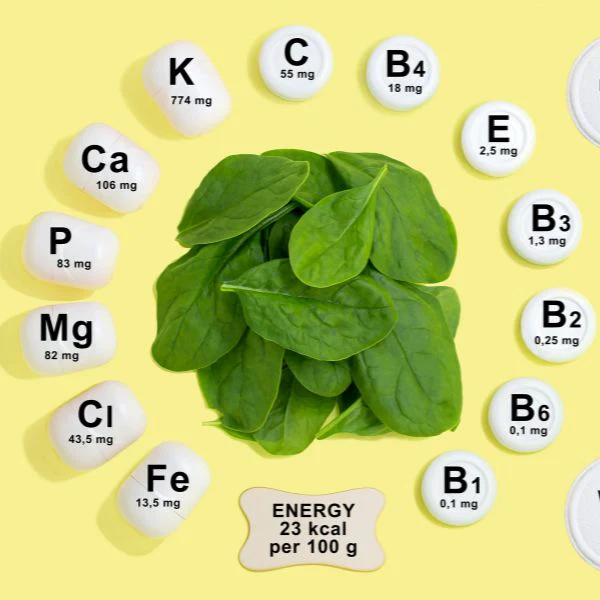
If we try to understand the difference between tulsi vs basil, we get to know tulsi is rich in Vitamin C ,calcium and iron which are helpful in building immunity, bone health and detoxification whereas basil is rich in Vitamin K,Magnesium and folate which is helpful in supporting bone health and many more.
Tulsi vs Basil : Which One is Better for You?
The choice you make totally depends on what purpose you are using for :
To Make Tea

Tulsi tea offers more benefits for you than basil tea; specifically, as herbal tea in Ayurveda, it helps you calm your stress and anxiety but also boost your immunity system.
Powder and Oil
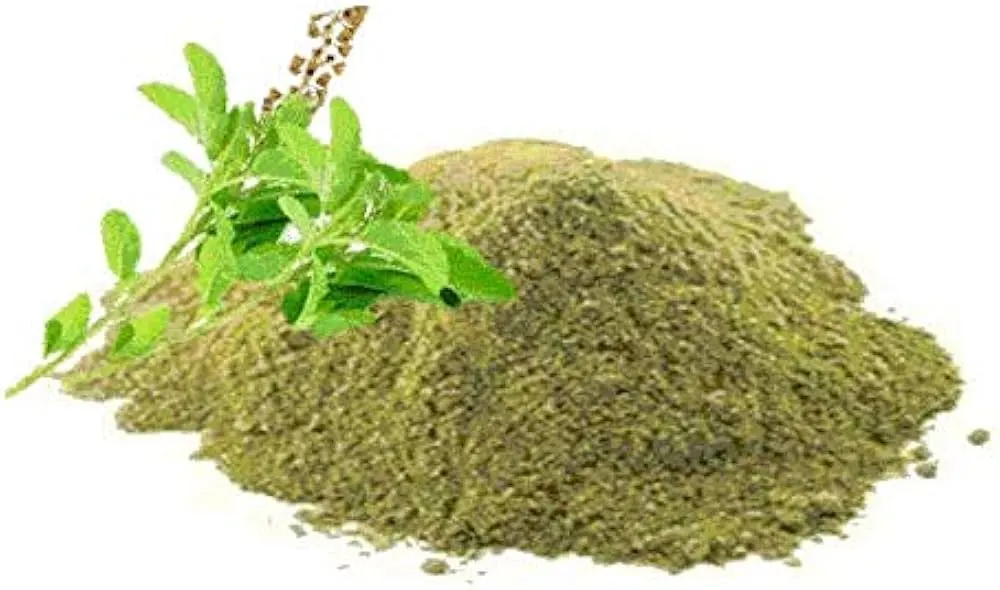
If you use tulsi products like powder to make tea, do skincare, and apply Ayurvedic treatments, whereas if you use tulsi oils in Aromatherapy, they help to improve mood, reduce stress, and tend to increase attentiveness.
Culinary Purpose

Chefs prefer Basil more for Italian and Mediterranean dishes, however, you can use Tulsi as a substitute for fusion dishes.
Tulsi vs Basil : Conditions for Growing Both Plants

Tulsi
When we talk about the difference between Tulsi and Basil, we learn that Tulsi requires warm, sunny surroundings and well-draining soil with regular watering, according to the climate condition, but not over watering it.
v/s
Basil
Like tulsi, it also needs a good sunlight and well-draining soil.
Tulsi vs Basil : Frequently Asked Questions
Yes, we can use tulsi instead of basil, however, it all depends on what recipes we are making. Generally, tulsi works very well with herbal teas, soups, kadhas, and some fusion dishes. On the other hand, basil goes very well with Italian dishes or Mediterranean recipes.
It is used as Herbal tea, soups, and ayurvedic medicines, and Basil is used in sauces, pizzas, pastas, and soups in Italian recipes.
It is better for stress relief as it contains Adaptogen which decreases cholesterol levels and promotes relaxation.
Tulsi holds great importance in Hindu culture; indeed, it symbolizes a woman and, furthermore, the earthly manifestation of the Goddess Tulasi, who, people consider an avatar of Lakshmi (The goddess of Wealth ) and, notably, a great follower of Lord Vishnu/Krishna. Moreover, people regard Tulsi as an important part of festivals like Diwali (Hindu festival) where they use its leaves as an offering to the God.
There are many types of tulsi, which include Rama Tulsi, Krishna Tulsi, Vana Tulsi, Kapoor Tulsi, and Amrita Tulsi. Additionally, basil has Sweet Basil, Thai Basil, and Lemon basil.
Conclusion
The decision you will make between Tulsi and Basil ultimately depends on what purpose you intend to use it for. I will say that if you are looking for amazing health, medicinal benefits, and religious significance, then choosing Tulsi is better. On the other hand, if you are looking more for culinary purposes and, furthermore, want to make Western medicines or dishes, you should go for Basil.
If you’re planning to grow Tulsi at home, check out our next blog on Planting Tulsi!
